I’ve worked hard to develop a green thumb through a lot of trial and error. Once, when I was at my wits’ end, I desperately felt that putting some really dejected houseplants near a water supply might help. Then, in spite of everything, they burst forth with joyful, glossy leaves and begin occupying my shower!
My plants were pleased to be in the bathroom, but I never gave it any thought as to whether this was a thing or not. And for my part, I was ecstatic to shower under a thick blanket of foliage—my very own little cloud forest.
In actuality, it makes complete sense. Most plants prefer moisture, and most bathrooms have plenty of it. Most bathrooms with a window will provide enough light, so my bathroom is not dark because it has a skylight.
Here are the plants that worked for me and other moisture-loving plants that will likely love living in your bathroom.
Eternity Plant (Zamioculcas zamiifolia)

The eternity plant lives up to its name with its ability to thrive in a variety of conditions and with minimal care. This resilient plant is ideal for those who may not have a green thumb, as it requires infrequent watering and can adapt to low to medium light. In a naturally lit bathroom, it can flourish with minimal intervention. Despite being relatively new to the houseplant scene, having only been commercially propagated since the 1990s, it’s well-regarded for its durability and ease of care. Also known as the ZZ plant, it’s celebrated for its hardy nature.
Light: Prefers bright, indirect light but can tolerate low and direct light.
Water: Water only when the soil is completely dry, sometimes as infrequently as once a month.
Soil: Needs well-draining potting soil.
Pet Safety: Toxic to both cats and dogs
Moth Orchid (Phalaenopsis spp.)

The moth orchid is perfectly suited for humid environments, making it an excellent choice for a bathroom, especially in drier regions. Unlike many orchids that can be tricky to care for, the moth orchid is known for being relatively easy to grow and frequently blooms. It thrives in bright, indirect light, ideally positioned near a sunny window to maximize its growth and flowering potential.
Light: Requires bright, indirect light.
Water: Water thoroughly when the soil feels dry to the touch.
Soil: Best grown in an orchid-specific potting mix.
Pet Safety: Non-toxic to both cats and dogs.
Spider Plant (Chlorophytum comosum)
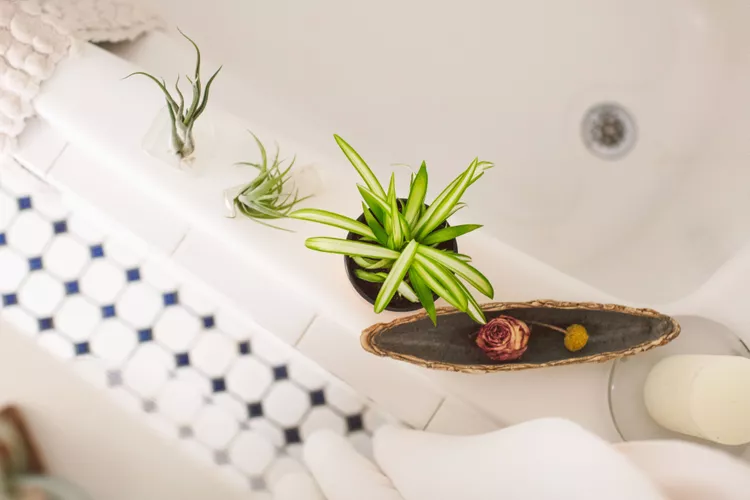
The spider plant is an excellent choice for beginners due to its tolerance for various conditions. It prefers moisture and can grow well even in low-light situations. Additionally, it is known for producing “spiderettes” that can be easily propagated. Its resilient nature and ease of care make it a popular plant for bathrooms.
Light: Thrives in indirect light.
Water: Requires regular watering when the soil dries out, more frequently in summer than winter.
Soil: Grows well in a standard potting mix.
Pet Safety: Non-toxic to cats and dogs.
Air Plant (Tillandsia spp.)
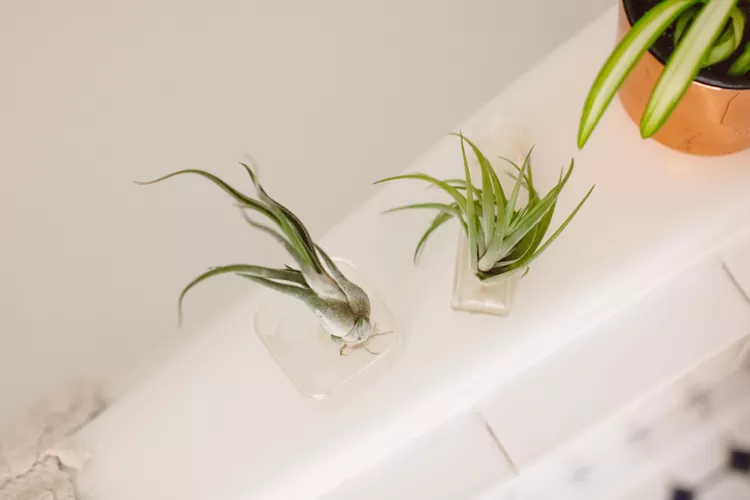
Air plants, with over 670 species available, are highly adaptable and well-suited to humid environments like bathrooms. These unique plants don’t require soil and absorb moisture from the air, making them ideal for low-maintenance care. Due to their popularity, it’s important to purchase air plants from reputable nurseries to avoid contributing to overcollection in the wild.
Light: Prefers indirect light and shade.
Water: Can be misted or kept in a humid environment, eliminating the need for traditional watering.
Soil: Not required.
Pet Safety: Non-toxic to both cats and dogs.
Snake Plant (Sansevieria trifasciata)

The snake plant is a low-maintenance choice that handles varying light conditions and humidity levels with ease. Known for its striking, upright leaves and resilience, it requires minimal attention and is an excellent addition to a bathroom. This succulent stores water in its thick leaves, and while it may occasionally bloom, it does so infrequently.
Light: Adapts to medium indirect light, and can also tolerate direct sunlight or shade.
Water: Regularly water, allowing the soil to dry out completely between waterings.
Soil: Needs a rich, well-draining potting mix.
Pet Safety: Toxic to both cats and dogs.
Lucky Bamboo (Dracaena sanderiana)
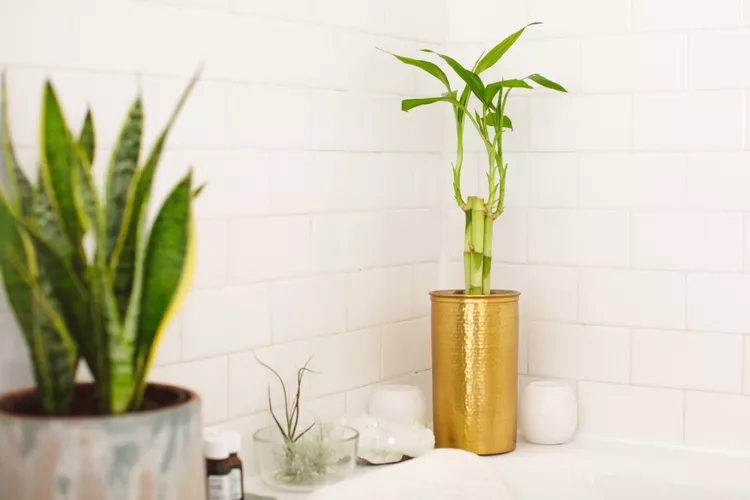
Despite its name, lucky bamboo is not related to true bamboo but is an African species related to garden asparagus. It thrives in water and can be grown without soil, although water changes should be done every few weeks. This plant is valued for its unique appearance and ease of care, making it a popular choice for minimalist decor.
Light: Prefers indirect light but can tolerate low light better than direct sunlight.
Water: Requires frequent watering.
Soil: Can be grown in water, but if soil is used, it should be rich and well-draining.
Pet Safety: Toxic to both cats and dogs.
Dragon Tree (Dracaena marginata)
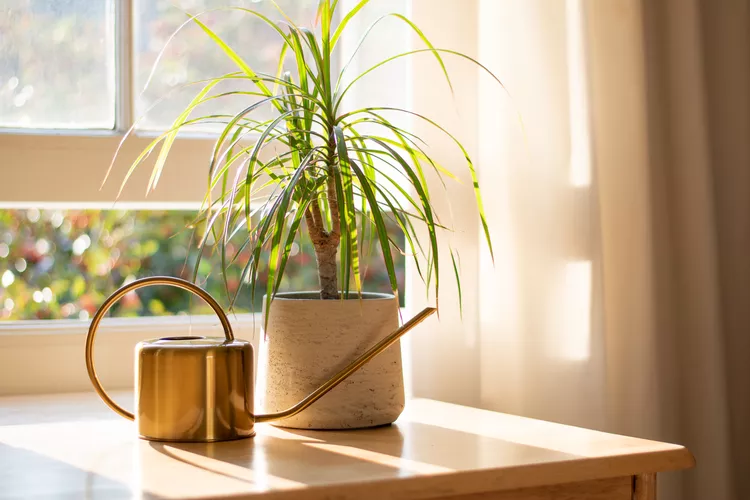
The dragon tree is a robust plant that thrives with minimal care and can handle both high humidity and dry conditions. Known for its dramatic appearance and tolerance for neglect, it’s one of the larger houseplants suitable for bathrooms. Outdoors, it can grow quite tall, but indoor varieties can reach up to six feet.
Light: Prefers low to medium indirect light and filtered sunlight.
Water: Keep the soil moist but not waterlogged.
Soil: Requires a rich, well-draining soil.
Pet Safety: Toxic to both cats and dogs.
Boston Fern (Nephrolepis exaltata bostoniensis)
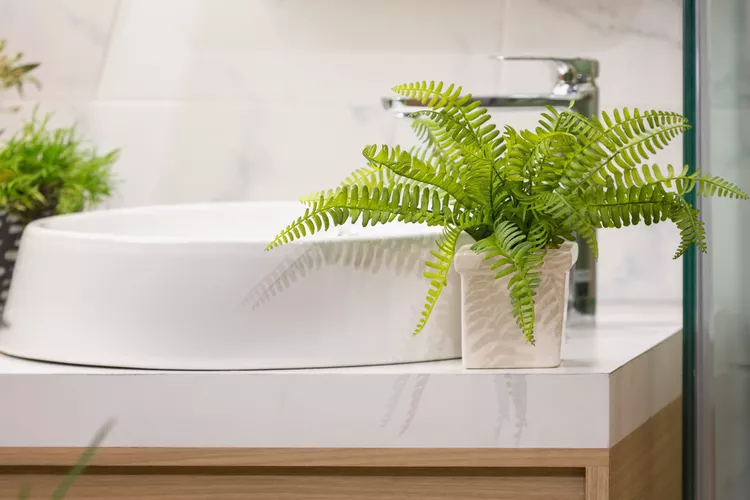
Boston ferns are a classic choice for bathrooms due to their preference for humid conditions. These attractive ferns can be displayed in hanging baskets or even placed in the shower, provided the pot drains well. Their lush, feathery foliage adds a touch of greenery and freshness to any bathroom.
Light: Prefers indirect light and dappled sunlight.
Water: Keep the soil consistently moist.
Soil: A loamy, rich potting mix works best.
Pet Safety: Non-toxic to both cats and dogs
Peace Lily (Spathiphyllum wallisii)

The peace lily is a resilient evergreen plant that thrives in warm, humid environments, making it well-suited for bathrooms. It can grow up to three feet tall and produces elegant white blooms that can last for several months. This plant prefers a mix of indirect light and shade, and its lush foliage can indicate when it needs water.
Light: Prefers filtered light or shade; too much sunlight can cause leaf issues.
Water: Water when the soil feels dry, typically once a week.
Soil: Needs a rich, loose potting soil with organic material.
Pet Safety: Toxic to both cats and dogs.
Golden Pothos (Epipremnum aureum)
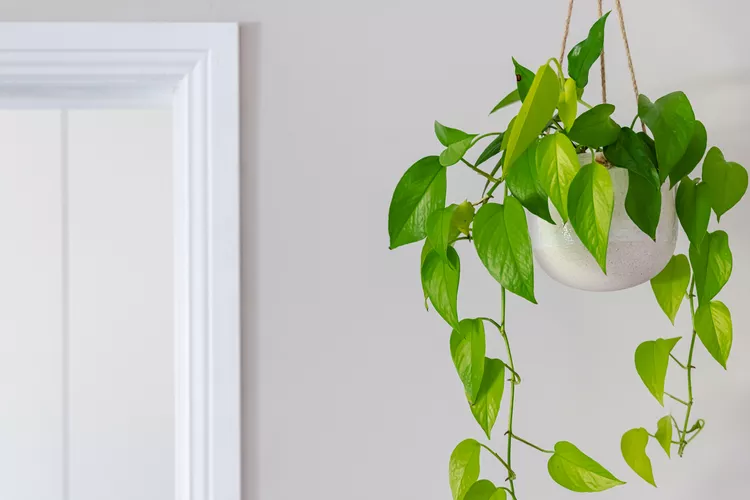
Golden pothos is a versatile and forgiving plant that thrives in high humidity and low light conditions. It’s a vigorous grower, capable of adding up to a foot of length per month, and its heart-shaped leaves can be trained on trellises or allowed to cascade freely. This plant adapts well to a variety of light conditions, including artificial lighting.
Light: Prefers bright, indirect light but can tolerate partial shade or artificial light.
Water: Let the soil dry out between waterings and water thoroughly when leaves begin to droop.
Soil: Ordinary potting mix that drains well.
Pet Safety: Toxic to both cats and dogs.

